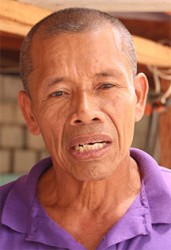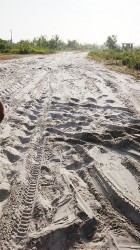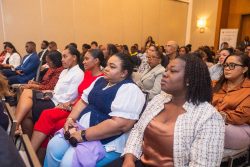There is opposition to the way the village is being run under his tenure, with some residents claiming that there is a lack of accountability and that issues are not being addressed.
But Toshao of St Cuthbert’s Mission Luke Simon also has strong support in the community and plans to run for re-election when his term ends in April 2015.
In an interview with Stabroek News, Simon said that in the three years he has been captain there were a few noteworthy accomplishments: four bridges were built, including the Mahaica River pedestrian bridge; the boat landing was refurbished; a benab measuring 60ft in diameter and 50ft in height was completed on December 21, 2013; an eco-resort was built and Simon talked about investing in eco-tourism. Under his leadership too, the community acquired a logging concession; electrical services were extended to the Kunabuli residential area; a bobcat was purchased to dig drains around the community along with filling potholes. In addition, the village has a vehicle and an outboard engine for a boat to transport sick people, emergency cases, visitors and other cases approved by the village council.

However, some residents have been critical of Simon’s leadership. Recently, a letter signed by ‘Concerned Citizens’ appeared in another section of the media where several problems and issues affecting the community were highlighted.

Amongst these criticisms was the lack of accountability of funds and resources. Some residents of the community are even contemplating sending a petition to the Ministry of Amerindian Affairs.
None of this deters the Toshao, who said that should he be re-elected, he will take a more serious approach to the rehabilitation of the Access Road from the highway to the mission. He intends to build a larger bridge over the Mahaica River that will facilitate vehicular traffic.
Simon also talked about the establishment of a museum, which will store traditional artefacts, and an institution for the preservation of culture.
The landing is currently under enhancement. “It needs more improvement,” he said. “It will have changing rooms and proper washrooms for visitors.” In his ambition to develop a tourism industry based on the culture and traditions of his people and the ecological environment, the Chief plans on expanding an eco-tourism resort a few miles from the village centre. A guest house, according to him, was already built and future plans see it housing a canteen, kitchen and restaurant.
These and other projects he has in mind will have to be taken to the Ministry of Amerindian Affairs and the Regional Democratic Council as procedure dictates.
Health care and security remain major issues in the socio-political affairs of St Cuthbert’s Mission. As it relates to security there are incentives to using community forums and schools to address the abuse of drugs and alcohol. A number of residents complained that young people had access to drugs and alcohol and were abusing these substances. As a result, one of the stipulations at this year’s Heritage celebrations was that visitors were prohibited from selling alcohol.
“It bothers me to hear healthcare to some extent is under-average. We are benefiting from government ventures but I feel doctors should come [to St Cuthbert’s] on a regular basis,” Simon said. He remarked that some people could not afford to travel to the coast for medical treatment.
The health centre is currently staffed by medics, a midwife and two health care workers. The community has trained midwives, but pregnant women are sent to deliver in Georgetown, two to three hours from the community.
“I don’t know the reason why,” Simon said, but this is among the issues that he will take to the National Toshao’s Conference which is currently slated for this month, October at the National Conference Centre, Liliendaal, Greater Georgetown.
St Cuthbert’s Mission is the only Amerindian settlement in the Demerara-Mahaica administrative region, just two hours south of Georgetown by road and accessed from the Linden-Soesdyke Highway. The community has a small but thriving population of Arawak and mixed people.





